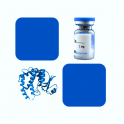
- Remove this product from my favorite's list.
- Add this product to my list of favorites.
Products
Newsletter
 |  |  |  |  |  |

Background
Tyrosine-protein phosphatase non-receptor type substrate 1 (SHPS1) also known as CD172 antigen-like family member A (CD172a), Macrophage fusion receptor, MyD-1 antigen, Signal-regulatory protein alpha (SIRPA or SIRP alpha) or p84, is a member of the SIRP family, and also belongs to the immunoglobulin superfamily. SIRP alpha is Ubiquitous and highly expressed in brain. SIRPA / CD172a is immunoglobulin-like cell surface receptor for CD47 and acts as docking protein and induces translocation of PTPN6, PTPN11 and other binding partners from the cytosol to the plasma membrane. SIRPA / SHPS-1 supports adhesion of cerebellar neurons, neurite outgrowth and glial cell attachment and may play a key role in intracellular signaling during synaptogenesis and in synaptic function By similarity. SIRPA / MyD1 involved in the negative regulation of receptor tyrosine kinase-coupled cellular responses induced by cell adhesion, growth factors or insulin and mediates negative regulation of phagocytosis, mast cell activation and dendritic cell activation. CD47 binding prevents maturation of immature dendritic cells and inhibits cytokine production by mature dendritic cells.
Source
Recombinant human SIRP alpha / CD172a Protein, Fc Tag (SIA-H5251) is expressed from human 293 cells (HEK293). It contains AA Glu 31 - Arg 370 (Accession # NP_001035111).
Predicted N-terminus: Glu 31
Molecular Characterization
This protein carries a human IgG1 Fc tag at the C-terminus.
The protein has a calculated MW of 63.9 kDa. The protein migrates as 70-105 kDa under reducing (R) condition (SDS-PAGE) due to glycosylation.
Endotoxin
Less than 1.0 EU per μg by the LAL method.
Purity
>95% as determined by SDS-PAGE.
>90% as determined by SEC-HPLC.
Formulation
Lyophilized from 0.22 μm filtered solution in 50 mM Tris, 100 mM Glycine, pH7.5 with trehalose as protectant.
Reconstitution
Please see Certificate of Analysis for specific instructions.
For best performance, we strongly recommend you to follow the reconstitution protocol provided in the CoA.
Storage
For long term storage, the product should be stored at lyophilized state at -20°C or lower.
Please avoid repeated freeze-thaw cycles.
This product is stable after storage at:
-20°C to -70°C for 12 months in lyophilized state;
-70°C for 3 months under sterile conditions after reconstitution.
Bioactivity
Please refer to product data sheet.
(1) "SIRP-alpha-IL-6 axis induces immunosuppressive macrophages in non-small-cell lung cancer"
Wang, Pan, Chen et al
Biochem Biophys Res Commun (2023) 682, 386-396
(2) "A novel CD47-blocking peptide fused to pro-apoptotic KLA repeat inhibits lung cancer growth in mice"
Pan, Hu, Chen et al
Cancer Immunol Immunother (2023)
(3) "[Radix Tetrastigme Polysaccharide Promotes Antitumor Immune Response
in Lewis Lung Cancer Mice]"
Zhao, Zhu, Lu
Zhongguo Fei Ai Za Zhi (2023) 26 (8), 559-571
Showing 1-3 of 154 papers.
(1) "Novel SIRPα Antibodies That Induce Single-Agent Phagocytosis of Tumor Cells while Preserving T Cells"
Authors: Andrejeva G, Capoccia BJ, Hiebsch RR, et al.
Journal: J Immunol 2021
Application: ELISA
(2) "Tumor-selective blockade of CD47 signaling with a CD47/PD-L1 bispecific antibody for enhanced anti-tumor activity and limited toxicity"
Authors: Wang Y, Ni H, Zhou S, et al.
Journal: Cancer Immunol Immunother 2020
Application: Flow cytometry
(3) "A novel fully human anti-CD47 antibody as a potential therapy for human neoplasms with good safety"
Authors: Yu XY, et al.
Journal: Biochimie 2018
Application: FACS
Follow us